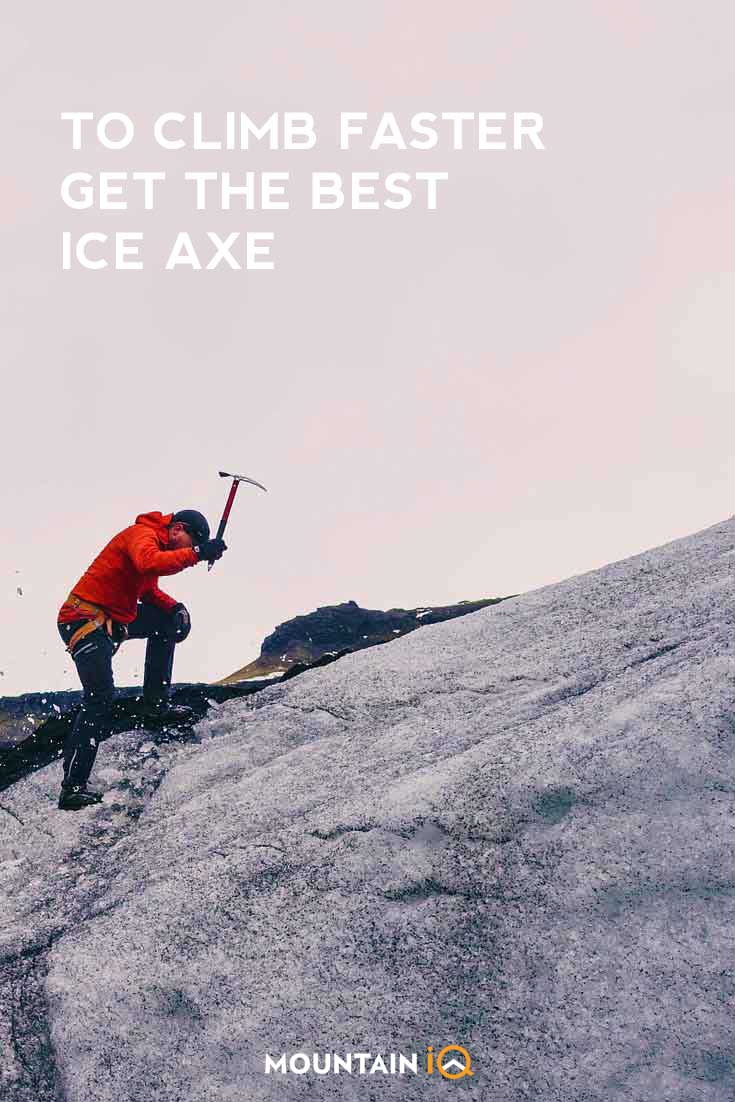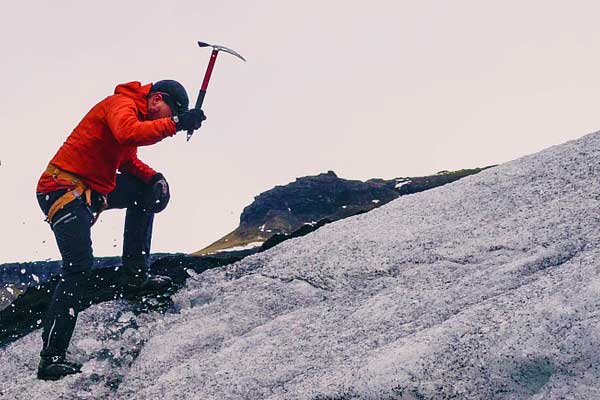Finding the best ice axe can be tricky. The most important factor of an ice axe is its length. It is measured from the tip of the axe to the top of the head. The average ice axe will be between 50cm and 75cm.
To find the right length ice axe based on your size, hold it while standing upright and relaxed with your arms by your sides. The spike should fall somewhere between the bottom half of your calf and the top of your ankle.
Here are 5 good ones to try out for your next outdoor adventure.
Best Ice Axes (Top Picks)
Best Overall
Best Value
Best Lightweight
This article contains affiliate links. If you buy something through the links on this page, we might get a small commission. It will not affect your price but helps keep our site alive!
Top Ice Axes For Climbing
My top 5 ice axes:
- Petzl Summit Evo - Best Overall
- Black Diamond Venom Adze
- Petzl Quark Ice Tool
- CAMP Corsa Ice Axe - Best Lightweight
- Black Diamond Raven - Best Value
Read our complete buyers guide for ice axes.
Best Overall Ice Axes
1. Petzl Summit Evo
The Petzl Summit Evo remains light while being incredibly strong and high-quality.
The higher part of the shaft is curved, providing great clearance on steep, icy terrain, while the lower part is more straight, allowing you to dig into snow.
To ensure good anchoring, the head of the ice axe has been forged and well-balanced, and the thin pick is toothed at the tip to bite into hard snow and ice while being thicker in the middle to anchor in soft snow.
One of our favourite things about the Summit Evo is its grip. With a waterjet-formed tube, the ice axe has extremely comfortable grip under the head.
Check Latest Prices
Main Features
What we like
What we dislike
Key Takeway
The Petzl Summit Evo’s durability and efficient design – a lightweight shaft with a strong head – has made it the tool of choice for every type of alpine venturing, as well as our top-rated, all-round ice axe.
2. Black Diamond Venom Adze
It is the adjustability of the Black Diamond Venom Adze that makes it able to conquer several types of mountain missions, and this has made us rank it the most versatile.
The stainless-steel head is designed to be fully interchangeable and compatible with any Black Diamond pick, and the adze is sharp enough to chop ice.
This makes it great for climbs with a variety of terrains.
The asymmetrical angled shaft and integrated grip make for safe and easy handling when swinging it like an ice tool, and the sliding FlickLock pommel has an adjustable second grip for steep snow.
You can also slide the pommel to just under the adze so it won’t get in your way during self-arrest.
Check Latest Prices
Main Features
What we like
What we dislike
Key Takeaway
The Black Diamond Venom Adze combines an ice tool’s precision with a piolet’s classic alpine functionality to create an ice axe that can conquer a variety of winter terrains.
3. Petzl Quark Ice Tool
The Petzl Quark Ice Tool has an aggressive pick designed for stable placements and a balanced hammer with a smooth swing, making it amazing for those vertical climbs.
The durable Cascade pick is bevelled so that it can be removed from ice easily, and its tapered tip can penetrate all types of ice. The pick’s shape allows steady hooking on both rock and ice.
The curved shaft offers awesome clearance – with smooth swinging and solid placements – while the ergonomic handles and the freedom from the leashes do a lot for forearm stamina on steep ice.
The short steel spike at the end of the shaft gives walking traction, and the grip provided on the axe is awesome. There is also a feature a the bottom of the shaft that holds the index finger to improve stability and precision when striking.
Check Latest Prices
Main Features
What we like
What we dislike
Key Takeaway
The swing, strike and stability that the Petzl Quark has to offer are second to none. It can pierce through all types of ice and snow, making it the most reliable choice for those trickier steep climbs
4. CAMP Corsa Ice Axe
Rumoured to be the lightest ice axe in the world, the CAMP Corsa Ice Axe only weighs 202g at its shortest length – less than half the weight of an average ice axe.
It is the full aluminium construction that gives the ice axe its low weight. The 7075-series aluminium also provides durability and dependability.
The hot-forged head shape is comfortable to grip and plunge, with a neutral tip that aggressively penetrates ice and an adze to chop it.
The shaft is designed for great precision, and the spike has a rivet at the end that stops snow from clogging inside the shaft.
If you’re aiming for an axe that can tackle intensive technical ice pitches or self-arrest on steep slopes, however, this axe won’t do you much justice.
It has a light build that’s preferable for early-season trails or lighter snow and is not suitable for vertical ice or mixed terrain.
Check Latest Prices
Main Features
What we like
What we dislike
Key Takeaway
Possibly the lightest ice axe in the world, CAMP Corsa Ice Axe is a durable axe that’s easy to carry and excellent for mountaineering.
5. Black Diamond Raven Ice Axe
This traditional ice axe has amazing quality for its great price, which is a good $30 lower than the average ice axe and the reason we have ranked it the best budget ice axe.
The Black Diamond Raven is a simple design with a long pick that bites into snow and ice as well as a wide grip area, making it comfortable to carry and more secure in the holder’s hands.
It has a great swing for chopping steps and works great for lower-angled terrains, traverses and glissading.
The 7075-aluminium shaft lowers the weight without any cost to the strength, while the stainless-steel head and spike are weather-resistant and rust-resistant.
Purchase this axe if you don’t quite know what you’re doing yet, as you can abuse it quite a bit while figuring techniques out.
Check Latest Prices
Main Features
What we like
What we dislike
Key Takeaway
The Black Diamond Raven Ice Axe is, overall, a basic ice axe that’s sturdy, strong and durable whilst remaining light in weight and low in price.
Ice Axe - Buyer's Guide (Key Features)
An ice axe is a multi-purpose hiking and climbing tool that is comprised of a head (with a pick and adze) and a shaft (with a spike).
Ice axes can be used in a cane-like fashion to traverse epic, snowy alpine summits, or paired with crampons to meticulously climb up frozen waterfalls.
The axe that you would need for a day of technical ice climbing is designed quite differently from a mountaineering axe.
Use our guidelines below to make sure you get the axe with the best performance ability for your intended purposes.
Length
Your intended use should also influence your choice in length. Short axes don’t offer much leverage and provide poor arrest. They are generally considered to be for technical ice-climbing. Axes over 70cm are too long for technical snow and ice climbing but are excellent at lower-angle terrain.
They are used for cross-country travel, building snow anchors, scrambling or probing for crevasses; although an axe that is too long will make self-arrest tricky as the spike can catch in the snow (causing you and your axe to fall miserably).
It is recommended to find a balance between these two factors, with a slight deviation toward the one that you will more likely indulge in (i.e. Use a slightly shorter ice axe for steeper terrain and a slightly longer ice axe if you plan to spend more time in lower-angled terrains).
Weight
Aluminium ice axes tend to be the lightest.
Lightweight axes save weight while increasing your speed, making them a great choice for ski mountaineering, trekking and glacier travel.
However, lightweight axes ten to be at a cost to durability and hardiness. They often struggle to penetrate hard ice.
Alloys and stainless-steel axes are heavier but are much more durable and stronger, piercing hard ice with much more ease.
This makes them better for general mountaineering, couloir climbing, mountain rescue and ice or mixed climbing.
Pick Curve
An axe’s pick curve comes in one of three styles: classic, reverse and neutral.
However, modern ice axes normally use either a classic or reverse curve pick, so we will focus on these two styles. Keep in mind what aspect of ice climbing you struggle with most, and pick a style that will benefit you in that area.
The classic curve (a.k.a positive curve) is fantastic at self-arrest, and ideal for steeper ice climbs.
The shape allows you to climb with much more security than what a neutral curve can offer, but it also makes it a bit harder to pull out of ice.
A reverse curve style (a.k.a reverse positive) is much nicer to remove from ice, and because of this almost all technical ice tools use it.
Adze vs Hammer
These features are located at the back of the ice axe head.
The adze is a flat, shovel-like feature that is almost always on a mountaineering axe. Its design makes it able to dig snow anchors, chop a tent platform, step cut or even dig a snow cave. It also provides an awesome surface area for grip during self-arrest.
The need for adze is much lower for climbing technical ice or mixed routes, though. Many ice tools use a hammer instead, which can be used to pound in pitons.
Most modern ice tools have a modular (adjustable) head, which is a great feature as you can then switch between adzes and hammers as needed, as well as cut down on weight by removing them completely.
Other things to look out for
CEN rating: B (basic) stamp axes are generally lighter, inexpensive, less durable and not recommended for technical climbing. Use them for general mountaineering. T (technical) stamp axes are heavier, expensive, more durable and ideal for technical climbing.
Leashes: Shorter leashes allow more control during a fall and longer leashes are better for technical or steep, snowy mountaineering.
Shaft: Curved shafts are designed to swing into ice – best for technical mountaineering and ice climbing. Straight shafts are best for self-belaying, plunging and general mountaineering.
Continue browsing
See more outdoor equipment reviews and our detailed climbing gear guide. Or check out these reviews:






